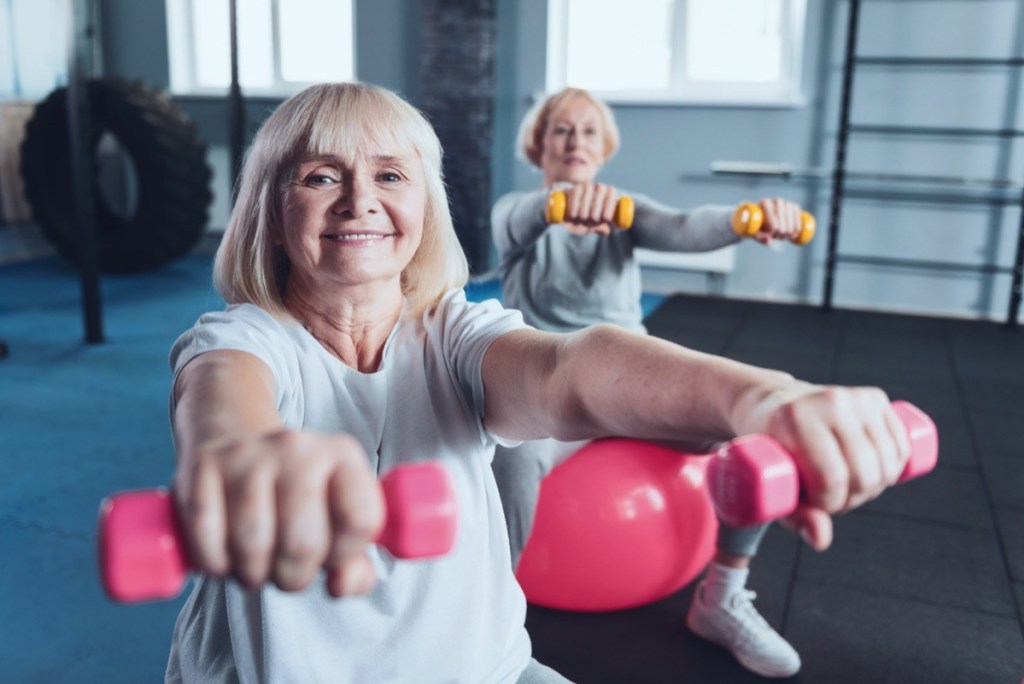
It’s never too late to start focusing on yourself. In fact, your 50s are the perfect time to prioritize your fitness. Because now that you’re older, working out isn’t just about looking better—it’s about feeling better and being able to maintain your mobility and health for decades to come.
Herein, we’ve rounded up 10 expert-approved everyday changes that will get—and keep—you fit now and for years down the line.
Rethink your idea of exercise
Trying to stay fit after 50 can be intimidating if your idea of exercise is only those heart-pounding, high-energy workouts. According to Harvard Medical School, there are many different activities that count as exercise that you probably haven’t even thought of.
Things like moderate housework (like sweeping and vacuuming), gardening, ballroom dancing, and canoeing also help get your heart rate up and bring on the health benefits.
Go to group fitness classes
One of the best ways to encourage yourself to work out is to sign up for a group fitness class. Many studios even offer free or discounted trial periods, making it easy to figure out where you feel most comfortable and which types of workouts you enjoy. After you start attending classes regularly, you’ll get into a routine—and maybe even make some new friends along the way.
Eat more plant-based meals
Staying fit means filling your body with wholesome foods that improve your health and wellbeing—and evidence suggests that plant-based sources might be best. One 2019 study published in the Journal of the American College of Cardiology found that sticking to a plant-based diet can decrease your heart failure risk by more than 40 percent.
Another study published in 2019 in The Journal of Nutrition found vegans tend to be healthier than those who follow other diets. So ditch the processed meat and sugar and fill your plate high with fruit, veggies, whole grains, and plant-based protein instead.
Chat with your doctor about your fitness
Regular doctors appointments benefit your health during every stage of your life, but it’s especially important to keep up with them in your 50s. “Be sure to talk about heart health and exercise with your doctor,” says Michael James, a trainer at the boxing gym EverybodyFights.
“They’ll let you know exactly what you can and cannot do based on your current health and any medications you may be on.”
Track your steps
One of the easiest ways to stay fit after 50 is to simply make sure you’re moving around enough during the day. Invest in a fitness tracker that tracks your steps and then make it your mission every day to hit your goal.
One study published in the Journal of Physical Activity and Health found women over 50 should be walking 10,000 steps a day and men over 50 should be walking 11,000 in order to control their weight and be healthier overall.
Cut back on salt
It’s hard to resist super-salty snacks, but it’s time to start practicing a little more self-control. According to the Cleveland Clinic, as you get older, you’re more likely to develop high blood pressure due to your changing blood vessels.
That puts you at higher risk for everything from a stroke and heart attack to kidney disease and death. To lower your risk of high blood pressure, cut down on salt—especially the high amounts of sodium in processed foods—so you can stay fit and healthy for years to come.
Don’t forget to warm up
Your warm-up is just as important as your workout. According to the National Institute on Aging, it’s important to do one before every workout to get your blood flowing and raise your heart rate. This can be as simple as walking on the treadmill, doing some jumping jacks, or going on a quick jog around the block—whatever helps your body loosen up and prepare for exercise.
Don’t limit yourself to cardio
If you hate cardio, that’s not the only way to stay fit—not by a long shot. “A majority of my clients who are in their 50s believed that cardio was the only thing they needed to be doing to stay in shape or improve their health,” says James. “It wasn’t until we added strength training that they truly started to see and feel the benefits of the time they spent in the gym.”
According to James, resistance training can help improve your balance, control blood sugar, build bone density, increase your metabolism, and even prevent sarcopenia, which is age-related muscle loss.
Drink enough water
Think of water as your body’s fuel. If you’re not getting enough, how is it supposed to run correctly? The Mayo Clinic says water helps your body control temperature, protect sensitive tissues, lubricate and cushion your joints, and aid in digestion—all things you might need extra help with as you age.
For men, that means getting at least 3.7 liters of fluids a day, and for women that means 2.7 liters of fluids a day—more so if you’re exercising, since you need to replace lost fluids.
Always focus on form
As long as you get the exercise done, you’re benefiting your health, right? Well, according to the National Federation of Professional Trainers, you’re not going to do any good without proper form.
If you don’t perform exercises correctly, you could be putting yourself at risk of injury that’s only going to slow you down. If that means ditching heavy dumbbells for lighter ones so you can perform the movements correctly, that’s what needs to be done. You’ll build and tone your muscles and be safer in the process.

























